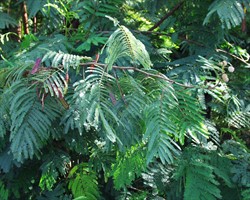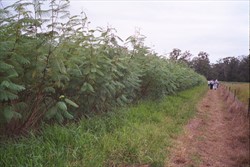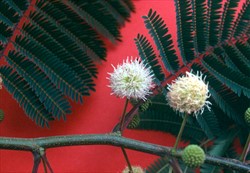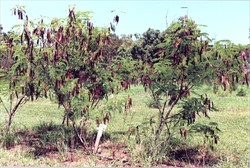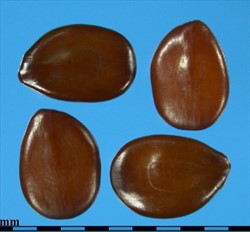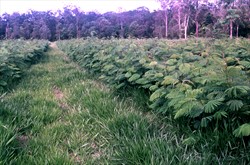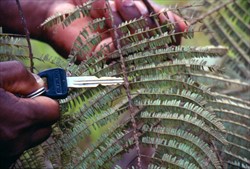Leucaena pallida
Tropical Forages
Leucaena pallida Britton & Rose
Leucaena esculenta (DC.) Benth. subsp. paniculata (Britton & Rose) Zárate; Leucaena paniculata Britton & Rose
Family: Fabaceae (alt. Leguminosae) subfamily: Caesalpinioideae (mimosoid clade*) tribe: Mimoseae.
* Azani, N. et al. [97 authors from 54 institutions] 2017. A new subfamily classification of the Leguminosae based on a taxonomically comprehensive phylogeny. Taxon 66: 44–77.
Small to medium, deciduous, multiple-stemmed, open crowned tree 3‒7 (‒10) m tall. Leaves paribipinnate with 15‒27 pairs of pinnae, variable in length up to 35 cm, with an un-stalked, crateriform petiole gland (up to 4.0 mm long × 3.2 mm wide); pinnules 39‒50 pairs/pinna, 6‒8 (‒10) mm × 1‒2 mm, asymmetric truncate at base, linear or linear oblong, acuminate at apex. Capitulum 14‒16 mm in diameter, 95‒110 flowers per head, in groups of 3‒5 in leaf axils on actively growing shoots, sometimes with suppression of leaves on the flowering shoot, flowers appear pale pink or dull purplish mauve; stamens (10 per flower), pistil 10 mm long, anthers pilose. Pod linear, 12‒19 cm × 14‒18 mm, slightly thickened and leathery, glossy maroon unripe turning mid reddish- or orange-brown, glabrous or occasionally hairy. Seeds 18‒22 per pod, 6‒8 (‒10) mm long, 5‒7 mm wide, brown, slightly rhombic.
Latin America: guaja, guajal, guajal de castilla, guaje, guaje barbero, guaje colorado, guaje de risa, guaje Delgado, guaje rojo, guajentudi, huaje, lobada le-eg, lya gusgih, ndwan duchi, texcalera, timbre
Native:
Northern America: Mexico (Guanajuato, Guerrero (e.), Jalisco (n.e.), Morelos, Oaxaca (n.), Puebla (s.), Zacatecas (s.w.))
Occurrences at Guanajuato, Jalisco and Zacatecas in northern Mexico may be from historic introductions.
Forage
Has been extensively evaluated in agronomic and animal production trials and used in hybridization programs with L. leucocephala and other species.
Other
In Oaxaca, Mexico, L. pallida is cultivated extensively for its edible pods and seeds, often in combination with L. esculenta (DC.) Benth., which is later flowering.
Soil requirements
Native to shallow calcareous soils. In exotic locations, has tolerated marginally more acidic soils than L. leucocephala. Otherwise has similar intolerance of low P, low Ca, high aluminium saturation, high salinity and waterlogging.
Moisture
In its native range, receives 500‒1,000 mm annual rainfall with a 5‒7 month dry season. In exotic locations has been very productive at sites receiving up to 2,000 mm annual rainfall.
Temperature
Grows at 1,100‒2,300 m asl in climates with average annual temperatures ranging from 16 to 21 ºC and experiencing occasional light frosts. More cool tolerance than L. leucocephala.
Light
Unknown. Probably reasonable, as it occurs as an understorey species in pine forests in its native range.
Reproductive development
Flowers through spring and summer and fruits through autumn and early winter.
Defoliation
Tolerant of regular cutting and grazing. Rarely heavily grazed due to low palatability.
Fire
Mature plants are tolerant of moderate intensity fires, regrowing readily from burnt stumps or branches.
Guidelines for establishment and management of sown forages.
Establishment
Establishes more rapidly than L. leucocephala due to larger seed size and inherent vigour of L. pallida. It is also marginally more tolerant of acid-infertile soils, otherwise has similar establishment requirements to L. leucocephala.
For best results plant on deep, well drained soils with a pH above 5.0 and maintain a weed-free area of at least 2 m either side of the establishing plants. Seed must be scarified to break the impermeable testa. Mechanical scarification, using coarse sandpaper (for small seed lots) or abrasive lined rotating drum scarifiers, is preferred. Specific rhizobium is required (e.g. CB 3060, TAL1145, LDK4).
Complete cultivation is recommended in extensive plantings. Planted into rows 4‒9 m apart at seeding rates of 1‒3 kg/ha. Post-emergent herbicides such as bentazone and imazethapyr can be used to control weed seedlings in the rows. Rolling cultivators can be used to control very young weed seedlings and break soils crusts after emergence of leucaena seedlings.
Small areas can be planted using seed or seedlings. Seedlings are normally raised in poly bags for plug planting at 3‒4 months old. Seedlings can also be raised in beds and removed for planting as bare-rooted seedlings if 'topped and tailed'.
Fertilizer
Normally not fertilized under rain-grown conditions. Starter N and P may be used when establishing into depleted soils on cropping lands.
Compatibility (with other species)
The low palatability of L. pallida under grazing has resulted in the formation of dense canopies and subsequently, low productivity of understorey grasses.
Companion species
Grasses: Has been grown in combination with Urochloa decumbens, but height management of L. pallida is required.
Pests and diseases
Most accessions (K748, CQ 3439, K376) are highly resistant to the psyllid insect, Heteropsylla cubana. Accessions identified previously as L. pallida , but now considered to be hybrids between L. pallida and other unknown species (K953 and OFI 52/87) are psyllid susceptible, whilst another, K806, is resistant. A range of pathogenic fungi and insects occasionally attack L. pallida. Newly emerged nursery and field-grown seedlings are commonly killed by damping-off diseases caused by the fungal species Pythium or Rhizoctonia. The soft brown scale (Coccus longulus) attacks the tall stems of L. pallida causing a reduction in productivity. The associated sooty mould that develops on the sugary exudates from the scale can cover the stems and temporarily kill under-storey grasses. Soft scale is generally an infrequent pest, with populations rarely building to cause economic damage. Soil insects such as earwigs, scarab beetles, termites and cut worms can cause serious damage to emerging seedlings and should be controlled using insecticide baits. Seed production can be reduced by the flower-eating larvae of the moth Ithome lassula, and by four species of seed-eating bruchid beetles of the Acanthoscelides genus.
Ability to spread
Will form thickets in grazed pastures if tree height is not regularly managed.
Weed potential
Being self-incompatible, less precocious, and with lower seed production cf. L. leucocephala, most accessions of L. pallida are expected to possess lower weed potential. However, accessions K748 and CQ 3439 have produced large quantities of seed (c. 0.5 kg/tree) in their first year of growth at Brisbane, Australia. Accession CQ 3439 is a composite accession and K748 may be of hybrid origin and this may affect their seed production. Given its low palatability to herbivores and seedling vigour, some accessions of L. pallida must be considered to have considerable weed potential.
Nutritive value
Low nutritive value; in vitro DM digestibility ranging from 55 to 64% of DM, but in vivo DM digestibility is low due to high concentrations (5‒17% of DM) of highly astringent condensed tannins. Crude protein concentrations 29‒35% of DM.
Palatability/acceptability
Palatability was low in short-term palatability trials and very low under free-grazing conditions in grazing trials.
Toxicity
Contains low concentrations of mimosine (< 2% of DM).
Dry matter
L. pallida is consistently reported to produce very high DM yields, with >10 t/ha/year forage being produced experimentally in favourable environments. In moderately acid soils (pH 4.9, aluminium saturation 40%), L. pallida will outyield L. leucocephala, producing forage yields of up to 2 t/ha/year.
Animal production
In Papua New Guinea, L. pallida CQ 3439-signal grass (Urochloa decumbens) pastures supported steer liveweight gains of 0.36 kg/head/day over an 8-month period, compared to 0.48 kg/head/day for steers grazing the signal grass control paddock. L. pallida quickly grew beyond the reach of cattle in this trial and had the potential to become a thicket.
In the Philippines, L. pallida CQ 3439-imperata (Imperata cylindrica) pastures supported steer liveweight gains of 0.23 kg/head/day over a 6-month period, producing a significantly higher mean liveweight gain compared with steers grazing the imperata control (0.14 kg/head/day), but much lower than for the L. leucocephala -imperata treatment (0.43 kg/head/day).
In northern Australia, L. pallida CQ 3439-signal grass (Urochloa decumbens) pastures supported steer liveweight gains of 0.42 kg/head/day over a 6-month period, producing a similar mean liveweight gain compared with steers grazing the signal grass control (0.38 kg/head/day), but much lower than for the L. leucocephala - signal grass treatment (0.72 kg/head/day).
L. pallida is a self-incompatible tetraploid with a chromosome number of 2n = 4x = 104 or 2n = 4x = 112. L. pallida is a tetraploid, probably with L. pueblana as the maternal parent. L. pallida hybridizes well with the tetraploid species L. leucocephala and L. diversifolia, but less well with L. confertiflora and the diploid species.
Produces abundant seed despite being self-incompatible. At Brisbane, Australia, approximately 0.5 kg/tree was harvested from 2-year-old trees. Susceptible to the bruchid beetle (Acanthoscelides macrophthalmus).
No information available.
- Comparatively rapid establishment.
- High psyllid insect resistance.
- High DM productivity.
- Low nutritive quality for ruminants, generally failing to improve ruminant production for all but the poorest basal diets.
- High concentrations of highly astringent condensed tannins render L. pallida a poor quality ruminant forage.
https://www.agric.wa.gov.au/sites/gateway/files/Hughes%2C%20Colin%20-%20Leucaena-species%20diversity%20and%20genetic%20resources.pdf (Leucaena: species diversity & genetic resources)
Castillo, A.C., Acacio, R.N., Deocareza, A.G., Vitorio, E.E., Moog, F.A., Galido, E. and Llarena, A.A. (1998) New Leucaena species and hybrids for livestock production. In: de la Vina, A.C. and Moog, F.A. (eds) Integrated Crop-Livestock Production Systems and Fodder Trees. Food and Agriculture Organization of the United Nations (FAO), Rome, Italy. p. 99–114.
Galgal, K.K., Shelton, H.M., Mullen, B.F. and Gutteridge, R.C. (2006) Animal production potential of some new Leucaena accessions in the Markham valley, Papua New Guinea. Tropical Grasslands 40:70–78. bit.ly/3dHYs99
Hughes, C.E. (1998) Leucaena, A genetic resources handbook. Oxford University Press, Oxford, UK. bit.ly/2Iw31af
Shelton, H.M., Gutteridge, R.C., Mullen, B.F. and Bray, R.A. (eds). (1998) Leucaena - adaptation, quality and farming systems. Proceedings of a Workshop Held in Hanoi, Vietnam, 9–14 February 1998. ACIAR Proceedings No. 86. Australian Centre for International Agricultural Research (ACIAR), Canberra, Australia. purl.umn.edu/135197
Note: Detailed updates on knowledge relating to Leucaena were provided in papers presented at the International Leucaena Conference held at The University of Queensland, Brisbane, Australia, 1‒3 November 2018. All papers were published under a publication agreement with the Organizing Committee in two Special Issues of Tropical Grasslands-Forrajes Tropicales: ILC2018 No. 1 - May 2019 Vol 7, No 2. 24 papers presented during Sessions 1‒4 of the Conference. http://www.tropicalgrasslands.info/index.php/tgft/issue/view/29/showToc and ILC2018 No. 2 - September 2019 Vol 7, No 4. 36 papers presented during Sessions 5‒8 of the Conference. http://www.tropicalgrasslands.info/index.php/tgft/issue/view/31/showToc.
No cultivars released.
CQ 3439 Selected in Australia. Composite accession developed by R.A. Bray, CSIRO from uncontrolled pollination among 15 L. pallida accessions collected from across the native range of this species. Despite their genetically heterogeneous parentage, trees are surprisingly similar in form and morphology leading to the speculation that relatively few accessions may have dominated fertilization in the seed orchard. CQ 3439 has been highly productive in comparison to several non-hybrid accessions in several trials pan-tropically.
K748 Selected in Australia, Hawaii. Origin Oaxaca, Mexico at 1,600 m asl in a 650 mm rainfall region. Very high yielding in sub-tropical and highland tropical locations. Used extensively in hybrid development by C. Sorensson, University of Hawaii. Maternal parent of the vigorous KX2 hybrid with K636 L. leucocephala promoted by the University of Queensland, Australia.
K376 Selected in Hawaii. Origin Oaxaca, Mexico at 1,675 m asl. High yielding in agronomic trials in Hawaii. Used extensively in hybrid development by J. Brewbaker and C. Sorensson, University of Hawaii. Maternal parent of the Hawaiian hybrid cultivar 'Ohana' with L. leucocephala K8.
